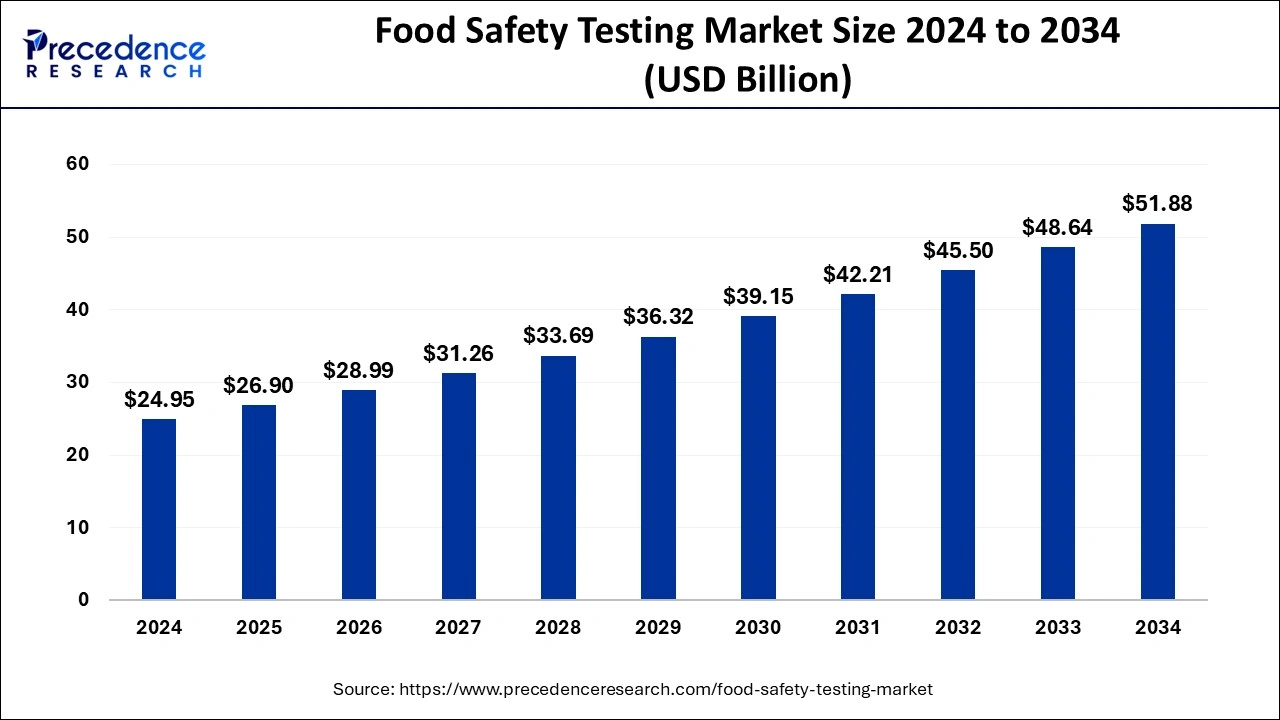Food safety testing market to expand at a 7.59% CAGR, reaching USD 51.88 billion by 2034.

- Asia Pacific led the global food safety testing market in 2024, holding a 41% market share.
- The processed food segment accounted for 37% of the market in 2024 and is growing at the fastest CAGR.
- Pathogen testing dominated the market by type, capturing a 42% share in 2024.
Detailed Overview
The food safety testing market is expanding rapidly as foodborne illnesses, contamination concerns, and regulatory requirements continue to drive demand for improved testing solutions. Food safety testing plays a crucial role in preventing health risks associated with pathogens, allergens, pesticides, and chemical contaminants in food products. The increasing complexity of global food supply chains has further intensified the need for reliable testing methods. Innovations in rapid detection technologies, including molecular diagnostics and biosensors, are transforming the industry by making testing faster, more accurate, and more accessible. The rise of clean-label food products and growing consumer demand for transparency are also influencing market growth.
Drivers
The primary driver of the food safety testing market is the rising prevalence of foodborne diseases, which have led to stricter food safety regulations worldwide. Governments are implementing stringent policies to reduce health risks, pushing food manufacturers to adopt high-quality testing protocols. Increased consumer awareness regarding food safety has also contributed to market expansion, with buyers demanding better quality assurance. Additionally, the adoption of automation and digital technologies in food safety testing is streamlining processes and improving detection capabilities, making it easier for manufacturers to comply with regulatory standards.
Opportunities
The shift toward sustainable and organic food production is creating new opportunities for the food safety testing market. As demand for organic and minimally processed foods grows, ensuring safety without synthetic preservatives becomes a priority. The development of portable and user-friendly testing kits is also opening new possibilities for on-site food safety analysis, reducing reliance on centralized laboratories. Emerging markets, particularly in Asia-Pacific and Africa, are investing in food safety infrastructure, presenting significant growth potential for industry players. Moreover, advancements in AI-powered predictive analytics are helping food producers detect potential contamination risks before they escalate into major health hazards.
Challenges
One of the main challenges in the food safety testing market is the high cost associated with advanced testing technologies. Many small and medium-sized food manufacturers find it difficult to afford comprehensive safety testing, limiting widespread adoption. The lack of standardized global regulations creates additional complexities for multinational food producers, who must navigate varying requirements across different regions. Furthermore, food testing processes often require specialized expertise, leading to longer turnaround times for results. Another challenge is the occasional occurrence of false positives and negatives in rapid testing methods, which can impact the reliability of test outcomes.
Regional Insights
North America leads the food safety testing market due to the presence of well-established regulatory bodies such as the FDA and USDA, which enforce strict food safety standards. Europe is another key region, driven by the EU’s comprehensive food safety regulations and increasing demand for high-quality food products. The Asia-Pacific market is growing rapidly, supported by government initiatives aimed at improving food safety and hygiene standards. Latin America and the Middle East are emerging regions where food safety concerns are gaining attention, leading to investments in testing technologies and infrastructure to enhance food quality control.
Recent News
Recent trends in the food safety testing market highlight the increasing adoption of next-generation sequencing (NGS) for pathogen detection, providing more detailed insights into contamination sources. Companies are also exploring blockchain technology to improve food traceability and prevent fraudulent activities in the supply chain. Regulatory agencies worldwide are tightening food safety guidelines, prompting food manufacturers to adopt advanced testing methodologies. Additionally, AI-driven food safety solutions are gaining traction, enabling real-time monitoring of contamination risks and enhancing overall food security measures across global markets.
Food Safety Testing Market Companies
- SGS S.A.
- Eurofins SGS Group
- TUV SUD
- Bureau Veritas
- Intertek
- Agilent Technologies Inc
- Thermo fisher Scientific Inc
- Shimadzu Corporation
- PerkinElmer Inc
By Food Tested
- Beverages
- Meat, poultry, & seafood products
- Dairy & dairy product
- Cereal, grain, & pulse
- Processed food
- Others
By Target Tested
- Pathogens
- E. coli
- Salmonella
- Campylobacter
- Listeria
- Others
- Pesticides
- GMOs
- Mycotoxin
- Allergens
- Heavy metals
- Others
By Technology
- Traditional
- Rapid
- Convenience-based
- Polymerase chain reaction (PCR)
- Immunoassay
- Chromatography & spectrometry
By Regional Outlook
- North America
- U.S.
- Canada
- Europe
- U.K.
- Germany
- France
- Asia Pacific
- China
- India
- Japan
- South Korea
- Middle East & Africa
- Latin America
Ready for more? Dive into the full experience on our website!
https://www.precedenceresearch.com/
